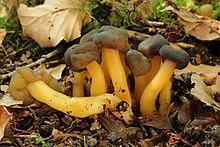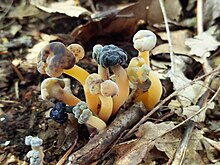Leotia lubrica
| Leotia lubrica | |
|---|---|

| |
| Scientific classification | |
| Domain: | Eukaryota |
| Kingdom: | Fungi |
| Division: | Ascomycota |
| Class: | Leotiomycetes |
| Order: | Leotiales |
| Family: | Leotiaceae |
| Genus: | Leotia |
| Species: | L. lubrica
|
| Binomial name | |
| Leotia lubrica (
Pers. (1797) | |
| Synonyms[1] | |
| |
Leotia lubrica, commonly referred to as a jelly baby, is a species of
The species produces small
L. lubrica has been recorded in Europe, Asia, North America, and Australasia. Growing in woodland among moss, plant detritus or other habitats, the fruit bodies are typically found in large numbers, though they can grow in tight clumps or even individually. The species may feed as a
Taxonomy
The first species was first validly described scientifically by Giovanni Antonio Scopoli in 1772.[2] Scopoli either named the species Elvella lubrica[3] or Helvella lubrica,[1] with the specific name lubrica meaning 'slimy'.[4] Christiaan Hendrik Persoon transferred the species to Leotia, where it remains, in 1794.[3] Other synonyms include Leotia gelatinosa, used by John Hill in 1751,[Note 1][5] Helvella gelatinosa, used in Jean Baptiste François Pierre Bulliard's Histoire des champignons de la France,[3][6] and Peziza cornucopiae, a name given by Georg Franz Hoffmann in 1790. The fruit bodies of the mushrooms are typically referred to as jelly babies,[7][8] but other common names include the lizard tuft,[9] the ochre jelly club,[10] the slippery cap,[11] the green slime fungus, and the gumdrop fungus.[12] The term "yellow jelly babies" is sometimes used to differentiate the species from green jelly babies, Leotia viscosa.[13]
Leotia lubrica is the
Description

Leotia lubrica produces
Each fruit body has a single fertile "head" measuring 1–3 cm (1⁄2–1+1⁄4 in) across,[8] which is an olive-greenish ochre and gelatinous.[7][18] To the touch, the surface of the head can be smooth, clammy or slimey.[8] While in shape it is convex, the head is made up of irregular lobes and undulations, and the edge is rolled inward.[7][8] The underside is paler in colour than the upper surface, and smooth.[19] The head is attached to a central stalk, which ranges from 2–8 cm (3⁄4–3+1⁄8 in) and 3–10 mm (1⁄8–3⁄8 in) wide,[18] though thinner toward the substrate.[7] The stalk is typically cylindrical, but can be flattened, and occasionally has furrows.[8] The colour is similar to that of the head, though more yellow, and the surface is covered in very small granules of a greenish colour.[7][8] The flesh is gelatinous in the head, while the stalk is mostly hollow,[7] but it can be filled with gel.[15] It has no discernible smell or taste.[9]
Microscopic features
L. lubrica
Similar species
L. lubrica fruit bodies are similar to those of Cudonia confusa, commonly known as the cinnamon jellybaby. The species can be differentiated by the fact that L. lubrica fruit bodies are more sturdy, and those of C. confusa are much paler in colour.[8] Another Cudonia species, C. circinans (which is highly similar to C. lutea), is similar to L. lubrica, though it can be differentiated by its colour (which is more brown), spores (which are smaller and thinner) and texture (which is less slimy and gelatinous than L. lubrica).[10] L. lubrica fruit bodies can also be mistaken for those of the much rarer L. atrovirens, which can be differentiated by its darker colouration.[9] L. viscosa can again be differentiated by colouration; the species has a green head,[19] although L. lubrica fruit bodies can also be greenish.[13]
Distribution and habitat

Fruit bodies are typically encountered from late summer to late autumn in Europe,[7] and from late spring to autumn in North America,[19] where it is the most common Leotia species.[15] It has also been recorded in eastern Asia, in China and Tibet,[3] as well as in New Zealand and Australia.[16]
L. lubrica favours damp deciduous woodland,[7][8] but can also be found under conifers.[19] Particular favoured habitats include path sides and underneath bracken,[7] while favoured substrates include soil, moss and plant waste.[8]
Fruit bodies are typically found growing in large numbers,[8] sometimes in clumps,[11] though solitary specimens are occasionally encountered.[11] Several bodies can be connected at their bases, or younger bodies can grow out of the bases of older ones.[17]
Ecology

While it has been conventionally regarded as a
Fruit bodies can be infected by the mould Hypomyces leotiarum (asexual reproduction form of Hypomyces leotiicola).[23]
Toxicity
Its fruit bodies are of little culinary interest,
Notes
- .
References
- ^ a b "Leotia lubrica (Scop.) Pers. 1797". Mycobank. International Mycological Association. Retrieved 27 June 2011.
- ^ Flora Carniolica exhibens plantas Carnioliae indigenas et distributas in classes, genera, species, varietates, ordine Linnaeano (1772).
- ^ ISBN 978-962-201-556-2.
- ^ Mosley, Oswald; Brown, Edwin (1863). The Natural History of Tutbury. p. 353.
- ^ "Leotia lubrica synonymy". Species Fungorum. CAB International. Retrieved 3 July 2011.
- ^ Bulliard, Jean Baptiste François Pierre (1780–93). Histoire des Champignons de la France (in French). Vol. 433. Paris, France: Chez l'auteur.
- ^ ISBN 0-330-26441-9.
- ^ ISBN 978-0-00-723224-6.
- ^ ISBN 978-0-261-67406-6.
- ^ ISBN 978-0-8156-3112-5.
- ^ ISBN 978-0-395-91090-0.
- ISBN 978-0-442-21998-7.
- ^ ISBN 978-0-271-02891-0.
- ISBN 0-681-45384-2.
- ^ ISBN 0-89815-169-4.
- ^ S2CID 20086665.
- ^ S2CID 84309803.
- ^ OCLC 797915861.
- ^ a b c d e f g h Kuo, Michael (June 2003). "Leotia lubrica". MushroomExpert.com. Retrieved 27 June 2011.
- ^ ISBN 978-0-7537-1865-0.
- PMID 25033922.
- ISBN 9783319563633.
- JSTOR 3793285.
- ISBN 0-00-458812-6.
- ISBN 0-02-063690-3.
- JSTOR 3793077.


